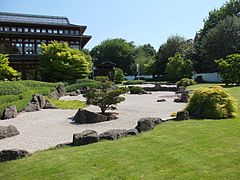Japanese garden (Bad Langensalza)
The Garden of Bliss ( Japanese 幸福 の 庭 , Kōfuku no niwa ) in Bad Langensalza , a spa town in the Unstrut-Hainich district in Thuringia , is a modern Japanese garden .
prehistory
In Bad Langensalza they were looking for a special garden theme to make the stay as varied as possible for the spa guest. So in 1999 the idea to create a Japanese garden was born. After a plot of land was found in the center of the village, construction of the building complex began in autumn 2001. In autumn 2002 the garden design by the garden architect Silke Hasskerl-Schilling with experience of Japan began. In August 2002, the garden was opened under the name Kofuku no niwa - "Garden of Bliss".
The garden
An approximately rectangular plot of land measuring 120 m × 60 m was available for the garden. The garden is laid out in the form of a Japanese convertible garden. In the middle of the northern half, a garden of the Karesansui type , a “dry garden” with light-colored gravel raked in lines, was laid out. In the gravel bed there are two small islands in the shape of the lucky animals crane and turtle in Japanese mythology.
In the southern half of the garden surrounds a pond, at the northern end of which is a stone lantern with a flat screen, a "snow viewing lantern" ( 雪見 燈籠 , yukimi-dōrō ). The lower western third of the pond is crossed by a zigzag footbridge ( 八 橋 , yatsubashi ) with irises growing on the sides . On the east side of the pond is the cherry orchard, on the south-west side, where the entrance is, a bamboo grove.
In addition to many other details, the seated stone Buddha in the azalea garden should be mentioned. Actually not typical for Japanese gardens, it - von Bad Langensalza won a city competition - has found a suitable place here.
The buildings
The main building is the two-storey plant pavilion built with lots of glass (Japanese paper-covered doors, Shōji , would not be suitable in our climate). On the upper floor there is a tea house, where you can take part in the regular tea ceremony. The plant pavilion is connected to the "Tea Drinking Pavilion" via a covered zigzag corridor, where green tea is served without a ceremony. On the east side is the small gravel garden with bonsai , which - understatably - is called Tsubo-niwa.
photos
Web links
Remarks
- ↑ In contrast to a temple garden, which is not entered, but only viewed from the temple area.
- ↑ Yatsubashi literally means eight bridge, where "eight" - 八 - does not refer to the number of bridge beams, but rather to the way in which the beams follow one another, namely angled.
- ↑ Tsubo is a Japanese square measure, about 3.3 m².
- ↑ The stone slab path is typical as a path to a tea house. It is called Roji and ends at the waiting area where the guests meet.
literature
- Silke Haßkerl-Schilling: Kofuku no niwa. Japanese garden in Bad Langensalza. ISBN 978-3-00-026902-8 .
Coordinates: 51 ° 6 ′ 45.4 ″ N , 10 ° 38 ′ 59.6 ″ E







